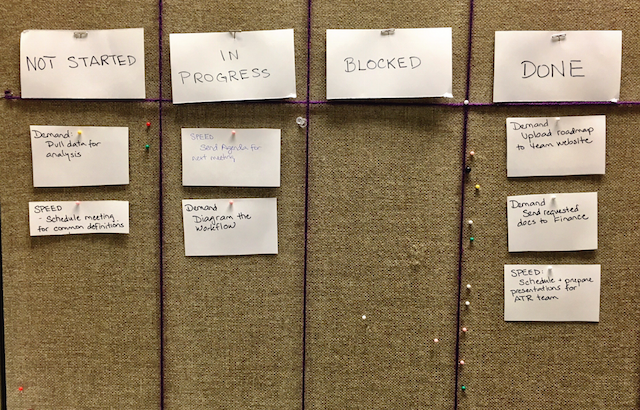Feeling frustrated and overwhelmed with your ‘to-do’ list? Let me show you how to easily set up a Kanban board. After years of keeping up with various ever-growing “to-do” lists, transferring items not yet addressed to new lists, and staring at my list a bit overwhelmed because there’s just so much on it – in no particular order of priority – I’ve discovered and embraced the Kanban board.
(Scroll to the bottom if you prefer to listen to the podcast version of this episode.)
I tried various different methods to tame my “to-to” list: identifying the top 3 items to complete that day, numbering the list in order of importance, etc. Then one day an acquaintance suggested I set up a Kanban board. I thought they were only for Agile teams. She explained that I can set one up solely for myself to replace the “to-do” list, and we whipped one up in just a few minutes.
How I Do It
I kept my Kanban board simple, with very few columns:
- Not Started –things that I need to do, but have not yet started.
- In Progress – Work that is in progress at the moment. This is also referred to WIP (Work In Progress). The main rule here is that there should not be many items in this column at any one time. You can only do so many things at one time, and if your WIP column gets too crowded, you need to move items that you are actually not working on back to the “not started” column.
- If you get redirected to something more urgent, and need to put what you are currently working on aside, it should come out of your “In Progress” column.
- Let’s say I’m working on a diagram laying out some process flows for a particular group, and my boss asks me to stop and instead create an initial draft of a short PowerPoint needed tomorrow. I’ll move my current activity card (diagram) back to the “not started” column (I know…I’ve actually started – maybe I’ll rename my column as simply “Backlog”), and instead whip up a card for “presentation” and begin work on it.
- Blocked – items that I am unable to move forward on for any reason. There are at times things that need to stay on your radar, but for some reason you cannot move forward, due to constraints – you are waiting for the Legal department to approve a contract, for example.
- Done – items that have been completed.
I’ve also seen variations. Some people label the “Not Started” column as “Backlog”. Some break work out into a “This Week” column and a “Today” column. You can make it your own – there is flexibility here. There are multiple electronic versions available also, but I use a cork board, pins, and notecards. Because I am working on multiple projects, I “tag” each card with the project name at the top. Many people use post-it notes on a white board.
The level of granularity for the tasks on my cards corresponds with what I would put on a “to-do” list. If the activity is very large, I break it out into smaller, more easily do-able chunks. When I’m ready to address something in my “In Progress” column, I pull that card off my Kanban board and lay it in front of me while I work – that is my only focus at the moment.
As I complete work, I move the cards to the “Done” column. The satisfaction of moving the card to my “complete” column, and seeing it grow through the week, is far more satisfying than merely crossing an item off a list. At the end of the week, I clear out the “Complete” column, and start fresh on Monday.
The key for me getting started was to keep it simple and just jump in and start using it – not overthink it.
Benefits
- Using a Kanban board allows me to visually see the work that I need to address, and be able to manipulate it in ways that I cannot with a static “to-do” list. I can intentionally select the cards that have the highest priority at the moment and move them into my “In Progress” column. If I get too much work in progress (WIP), I know I need to prioritize and direct my focus.
- By clearly seeing the amount of backlog that I have in my “not started” column, I can assess how each activity should be handled. If there are items that are not urgent, and continuously get passed over for more critical items, yet I know that they need to be done, I can have conversations about these tasks/activities with others in my office to see if they can be handled by someone else.
- Others can see my board, and this can serve as conversation starters for collaboration.
- Then of course there’s the satisfaction from seeing the “Done” column grow as I move cards over. That in itself can be quite motivating.
Implementing a Kanban board does not reduce the amount of work to be done, but I find it easer to prioritize. It’s been a great tool – I highly recommend giving it a try.




Hey Leigh, very timely article. I’ve been super frustrated with all the ways I keep my todo lists (tried all kinds of apps and software) and how they are just always a mess no matter how hard I try to keep some kind of order. I haven’t found a perfect system yet, but I am trying the Kanban boards. I actually wanted to suggest trying using Trello for that. I’ve been using it for a few months and love it. Great piece of software and it goes with me throughout the day (phone, tablet, laptop, etc). Have you used it before?
Hi Alex – thanks for the comment. I’ve also tried multiple electronic list systems but always found them lacking. I actually signed up for both Trello and Asana at the same time, and figured I’d give one a try before the other. I started with Asana and am using it currently. I like it so far. I like that there’s both a Kanban option and a list option. I’ve heard that Trello is the same. I’m curious to give Trello a try after trying Asana for awhile to see how it compares. Thanks for the reminder!
Leigh
Hi leigh, I am def trying this out. Its a great idea for my personal life as well. It will replace the loads of post it on my wall. Thanks again
Yes! We use a kanban board at home, too! It’s pretty intuitive for my daughter and it gives her the satisfaction of moving items to the “Done” column.
Awesome! I’m a list person and I coincidentally started doing this a few months ago myself! I was using kanban boards for project work, then realized I love dragging my virtual post-it’s, sorting and resorting my list.
I use Trello online do I can access it from almost anywhere, it’s free, and the interface is nice. I can also add comments, notes, links, and attachments to each”post-it”.
That said, I like your idea about physically picking up a card and placing it in front of you as you work on it, to help keep you focused; and the idea of having it where others could see it– you say for collaboration opportunities, but I say also just to make your hard work more visible and reduce the inquiries such as, “What are you working on?”
Thank you for validating my thoughts! I’m adding “share this article” to my kanban board! 😉
Giezelle – isn’t the kanban board the best? I have not tried Trello, but can see the appeal. I may give it a try.
Thanks for sharing!